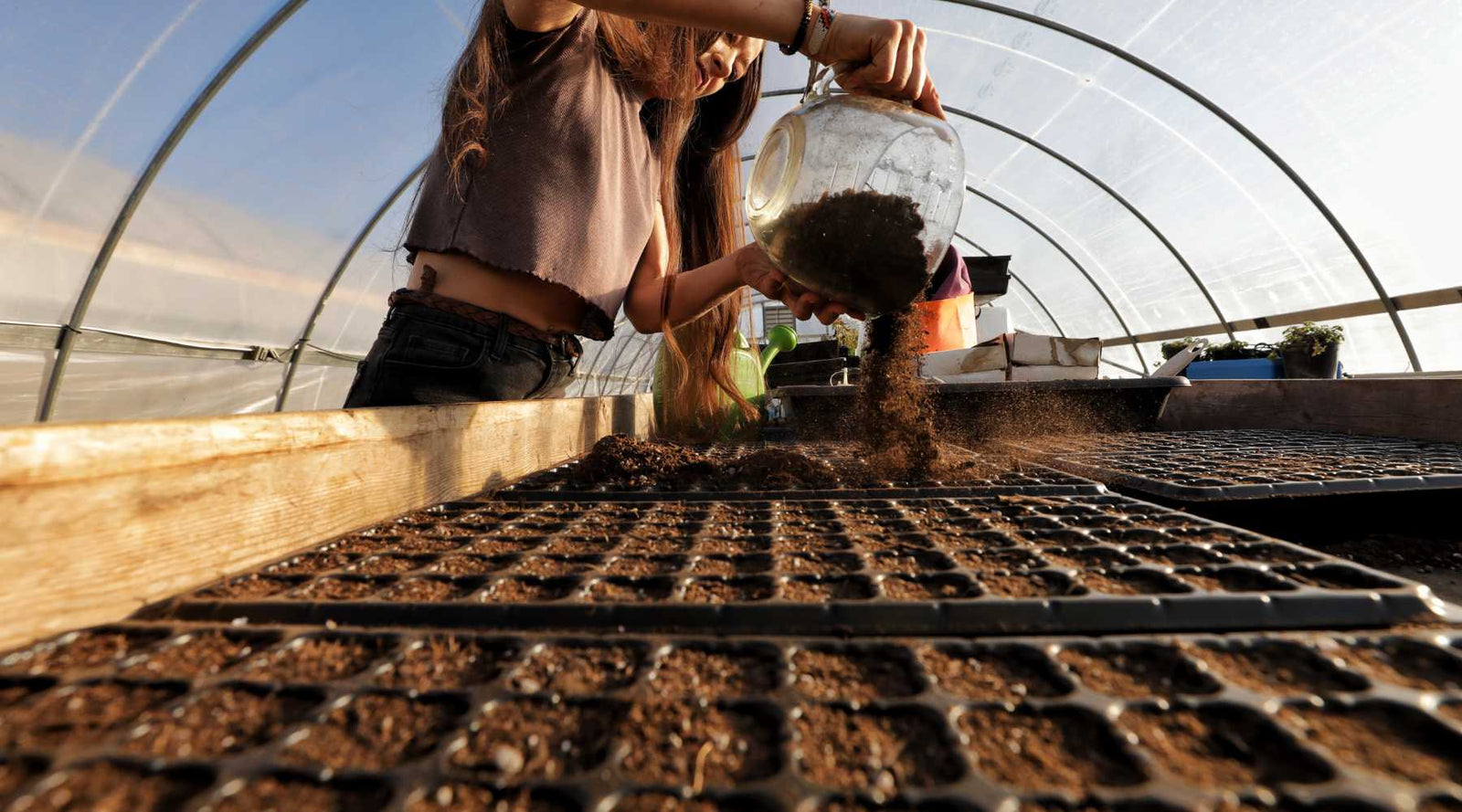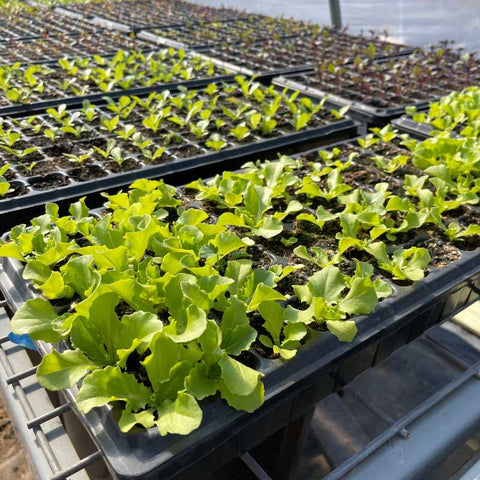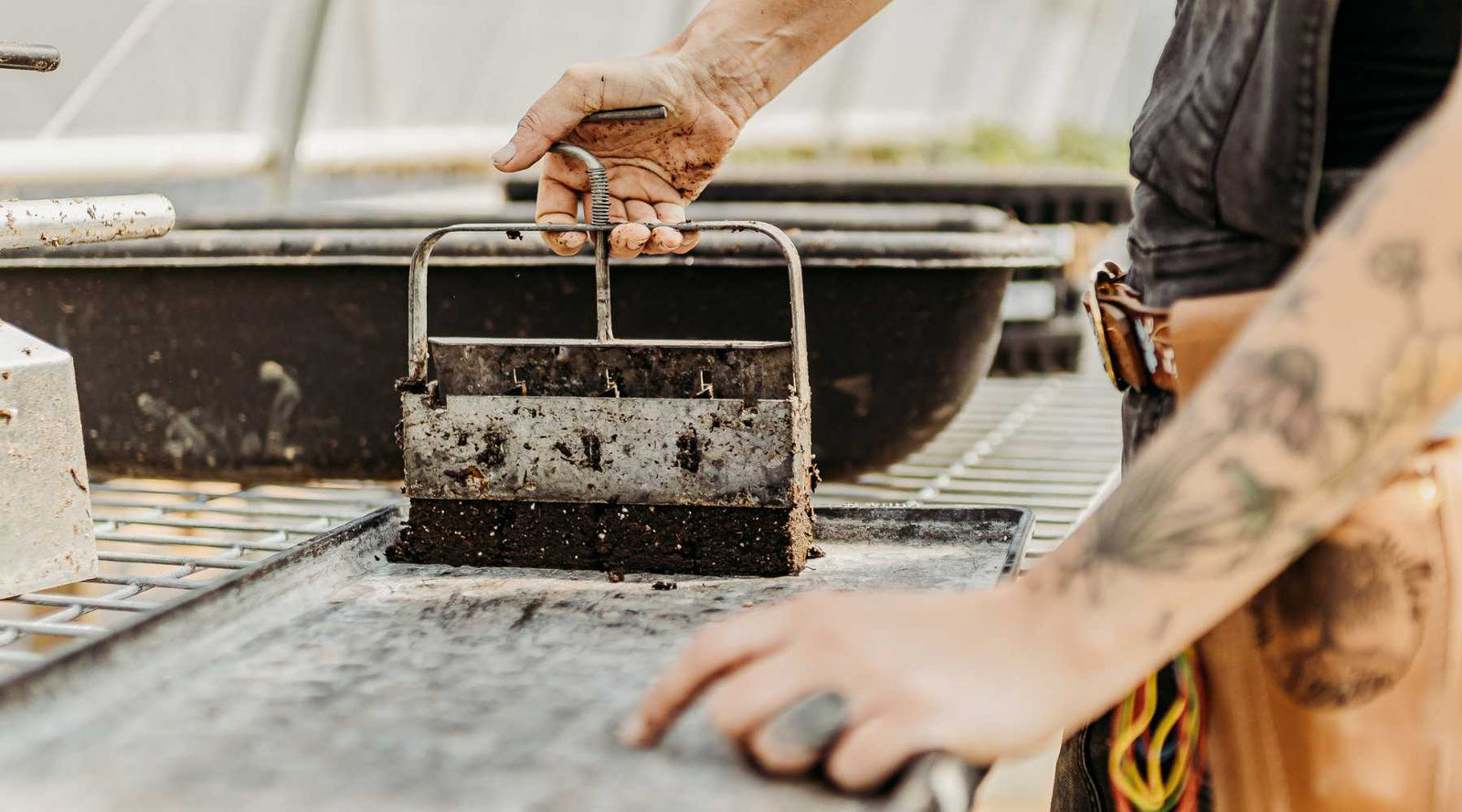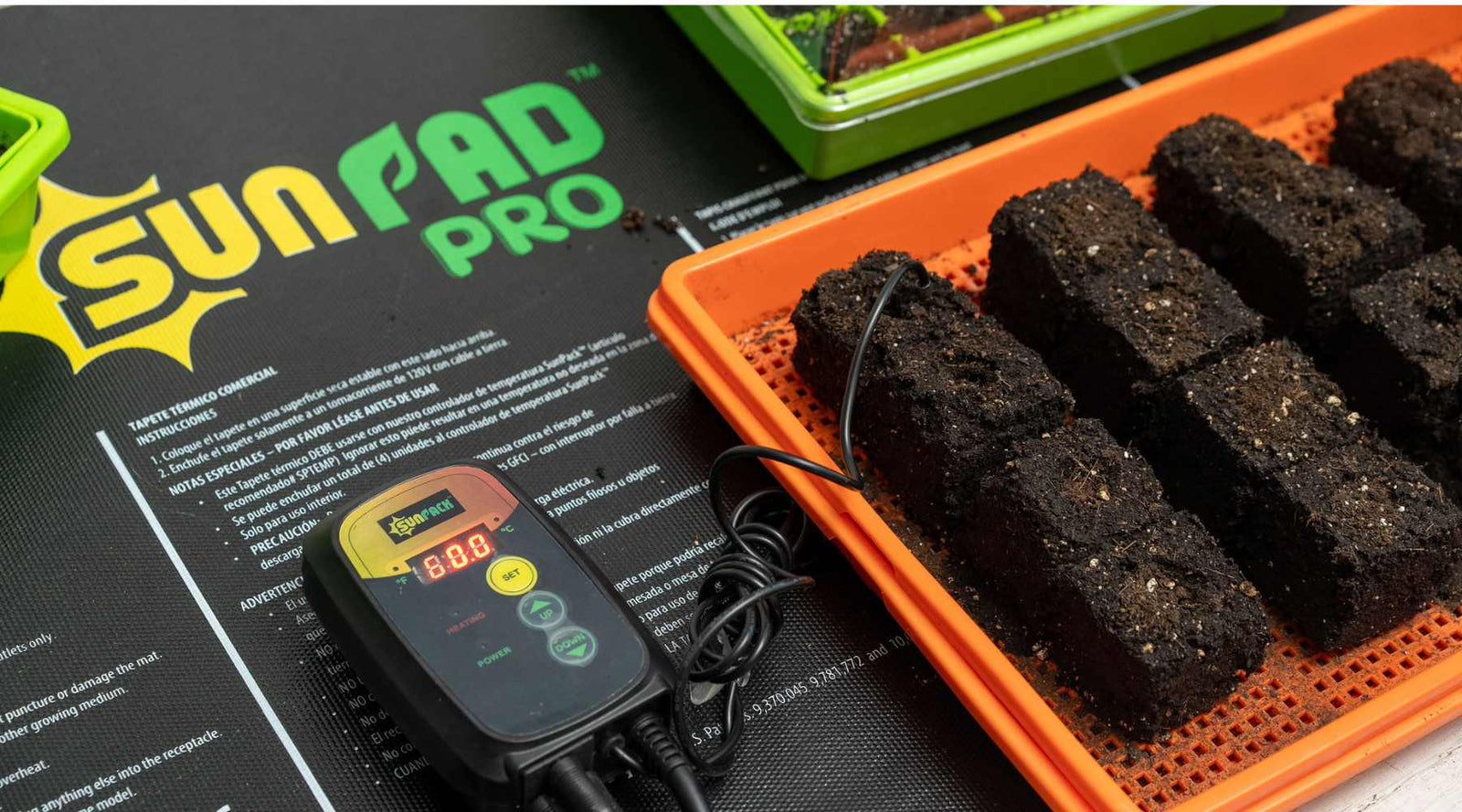Free Shipping on Orders over $75 to the Contiguous US
Free Shipping on Orders over $75 to the Contiguous US
Selecting the Right Seed Starting Cell Trays
August 21, 2025 8 min read 0 Comments

WHAT PROPAGATION TRAY IS BEST FOR YOU?
The best size cell plug seed trays for you to choose will be dependent on a few factors. We will go over the different options to help you select the best for you. Consider first, what is your intent in seed starting?
What size cell tray should I use?
Quickly review some of these seed starting questions.
- Are you growing a large number of one variety of plants for transplanting row crops?
- Are you planting smaller numbers of a wide variety of plants?
- Will you be planting your crops all at once, or will you be using the succession planting method?
- What type of seeds will you be planting? Peppers, tomatoes, lettuce, watermelon, etc.?
- How large are the seeds?
- How long will your seedlings need to stay in the cell trays?
- Will you be potting up your plant starts or planting out directly from the plug trays?
- How much protected growing space do you have to start seeds in?
- Will you use a heat mat or rely on ambient temperatures for germination?
Check out The Ultimate Growing Tray Guide video for a look at how these trays are commonly used.
Seed Starting Trays Comparison
| Tray Type | Cells per Tray | Cell Size (inches) | Recommended Plants |
|---|---|---|---|
| 4 Cell Seed Starting Trays | 4 | 2⅜" on top, tapers to 1¼" at the bottom | Sweet peas and other crops that need more room, great for up-potting |
| 6 Cell Seed Starting Trays | 6 | 1½" x 1½" x 2⅛" on top, tapers to 1" at the bottom | Sunflowers, Early Season Peppers, Early Season Vine Crops, Early Season Cole Crops (modular in 6 packs) |
| 32 Cell Seed Starting Trays | 32 | 2” square by 2” deep | Tomatoes, Melons, Cucumbers, Pumpkins, Squash, Peppers, and other large-seeded crops |
| 50 Cell Seed Starting Trays | 50 | 1¾" x 1¾" | Lettuce, Brassicas, Cucumbers, Slow-growing Flowers, and Herbs |
| 72 Cell Plug Seedling Trays | 72 | 1½” square by 2¼” deep | Sunflowers, Early Season Peppers, Early Season Vine Crops, Early Season Cole Crops, Lettuce |
| 72 Cell Air Prune Trays | 72 | 1.37" from the top, 2.29" tall, .87" hole, 1" at the bottom | Sunflowers, Early Season Peppers, Early Season Vine Crops, Early Season Cole Crops, Lettuce |
| 128 Cell Trays | 128 | 1” square by 2¼” deep | Lettuce, Herbs, Cole Crops, Celery, Leeks, Flowers |
| 200 Cell Trays | 200 | ¾” square by 2¼” deep | Lettuce, Brassica Crops, Small-seeded Flowers |
You can also use Cow Pots to plant things that don't do well with root disturbance like cucumbers, squash and some flowers. These 6-cell cow pots work nicely inside a mesh trays.
What size cell seed trays should I use for a Home Garden?

4 Cell Seed Starting Trays
Our brand new larger 4-cell plug inserts are deeper for growing varieties of crops that need a little more room. Eight of these removable inserts fit in a Bootstrap Farmer 1020.

6 Cell Seed Starting Trays
Our 6 cell trays have large 5/8 inch drainage holes on the bottom making it easy to remove your plant starts. They also make use of air pruning technology with long vertical slits on all 4 sides to prevent root circling in your seedlings. For easy color coding and tracking or your starts we are super excited to also offer our 6-cell trays in 5 cheerful colors. These are great for gardeners who will be starting a small amount of lots of different varieties as you can remove each type as it is ready without disturbing all the other starts that are sharing its heavy-duty 1020 deep tray bottom watering tray. 12 fit in each 1020 tray or 6 to a 1010 tray.
Shop Bundles & Kits here.
32 Cell Seed Starting Trays
The 32 cell plug propagation tray inserts are the largest cell seed starting tray size that Bootstrap Farmer carries, measuring 2" x 2". The larger size makes them perfect for canopy development of crops. You can also use this size as an insert tray to hold our 2.5" seed starting pots.
These cell seed tray inserts can be used in two ways. Directly plant into these cell inserts with deep drainage holes with Rockwool cubes, soilless media, or soil mediums. The entire tray can be bottom watered using a 1020 shallow tray with no holes.
Another way these insert trays are used is as a holder for these seed-starting pots. Seamlessly designed to sit in a 1020 shallow tray with no holes, the insert will hold 32 of these 2.5" pots, keeping them from tipping over in a 1020 trays and making quick work of transporting them out to the garden space. The individual seed cup style is very popular for school and community projects as these can go from seed to transplant without needing up-potting in between and come in bright colors and now in clear!

Recommended Plants: Tomatoes, Melons, Cucumbers, Pumpkins, Squash, Peppers and other large-seeded crops
50 Cell Seed Starter Trays
These 50 cell propagation trays are a happy medium of saving you space in your seed starting area while still being able to plant a large number of seedlings like lettuce that will be directly transplanted. Because the 50 cell tray has a much larger soil volume than the 72 cell plug trays or 128 cell trays, you will have a bit more wiggle room when you need to transplant for optimal root growth. Plants grown in these trays will be less likely to become root-bound if unsettled Spring weather delays your planting. This size also allows for canopy development of the seedling.
If you know that your seedlings will need to be potted up before they are ready to move outside, you will want to select one of the cell trays listed below or plan on potting up into larger pots like our new 5 inch grow pots with carrier.
Plastic trays of this size are great for planting early greens and brassica crops like broccoli and collard greens for the home garden. Just be sure that if you choose to mix varieties in one cell tray, they all have similar germination times and time to transplant.
Recommended Plants: Lettuce, brassicas, cucumbers, slow-growing flowers, and herbs.
The Best Cell Plug Tray Size for Large Scale Market Gardens

72 Cell Plug Seedling Trays & 72 Cell Air Prune Trays
The 72 Cell trays are the most popular choice amongst market gardeners. They are a good balance between space for growing and seedlings per tray. Each cell is 1.5" square and 2.25" deep, making them an excellent option for a large variety of plants. These plastic trays are also a good choice for vine plants. However, you will want to transplant the vine plants earlier than you would with the 32 Cell trays to prevent root bound seedlings. This cell plug tray is designed to use a heavy-duty 1020 deep tray for easy bottom-watering.

For optimal air pruning and extremely happy plants, we recommend our 72 air prune trays. All the benefits of soil blocking without the mess!
Recommended Plants: Sunflowers, Early Season Peppers, Early Season Vine Crops, Early Season Cole Crops (Cabbage, Cauliflower, Collards, Kale, Mustard, Kohlrabi, Broccoli, Brussels sprout, Watercress)
128 CELL TRAYS
These 128 Cell Trays are a great choice if you wish to start row crops or many baby greens. This configuration is ideal for starting many seeds but is not meant for crops that need more than a few weeks. Each cell is 1" square and 2.25" deep. You will be able to plant 78% more seedlings with one tray than the more common 72 cell seed starter trays. These 128 seed trays are compatible with the heavy-duty 1020 deep tray for bottom watering. You will want to up-pot your seedlings from this size seed tray into a larger pot or grow bag if you do not plan to transplant outdoors for an extended period to prevent seedlings from becoming root-bound.
Recommended Plants: Lettuce, Herbs, Cole Crops (Cabbage, Cauliflower, Collards, Kale, Mustard, Kohlrabi, Broccoli, Brussels sprout, Watercress), Celery, Leeks, Flowers.
200 CELL TRAYS
These 200 Cell Trays are excellent trays if you want to be economical about growing cole crops, lettuces, and other small-seeded crops. You will be able to grow ~2.8 times as many plants with one tray as you would with a 72 cell tray. Each cell is 0.75" square and 2.25" deep.
If you are using a 200 cell plastic trays to start seeds, you will need to transplant your seedlings at an earlier stage. Typically once they have one, at most two sets of true leaves. This plastic tray size is most frequently used by larger-scale farmers and those who intend to pot up their seedlings multiple times before moving outside. They can also be used to start plants going into hydroponic systems if you use a soilless media like coco coir or ProMix.
Recommended Plants: Lettuce and Brassica Crops (Cabbage, Cauliflower, Collards, Kale, Mustard, Kohlrabi, Broccoli, Brussels sprouts, Watercress), Small seeded flowers.
Common Questions About Planting in Cell Trays
Can I plant root crops in plug trays?
While some experienced farmers have successfully planted crops like beets and turnips in cell seed trays, it is not recommended unless your climate does not allow for the direct seeding of root crops. Carrots, parsnips, turnips, and beets rely heavily on their taproot. This long central root is responsible for much of the water uptake of these plants, and if the root is disturbed or damaged during the transplanting process, the plant will not thrive.
Can onions and leeks be planted in seed starting trays?
Yes, unlike other root crops, members of the allium family have congregate root structures. This means that they are much more tolerant of root disturbances during transplanting. It is common for growers to plant multiple small seeds per cell and tease them apart for later transplanting.
What are the advantages to starting seeds in cell trays vs. larger pots?
Starting seeds in cell trays, especially in the larger ones, gives the grower the advantage of being able to start more seedlings in their growing space. This is especially handy for row crops where the grower may want to plant 100 or more of each variety. Growing this many seedling starts in larger seed pots would take up way too much space. The other advantage is that you will waste less growing media starting out your seeds and then up-potting the successfully germinated starts into new pots.
Can you overwater seedlings in cell seed trays?
Yes. It is possible to overwater seedlings growing in cell trays. A common mistake growers make is to leave water in the bottom 1020 tray at all times. This will eliminate your seedling’s ability to get oxygen. Bottom-watering with a 1020 can be properly done by adding just enough water to allow the cell tray to evenly absorb it during the watering and no more. You want to discard the excess water as it will become stagnant and invite anaerobic bacteria to wreak havoc on your newly established seedlings.
Related: Easiest Way to Water Seedlings
How long can my plants stay in the cell tray?
Most seedlings can stay in cell trays for at least 4 weeks. The larger the cell volume, the longer a plant can grow before it becomes root-bound. Plants grown in a 200 cell tray will typically need to be potted up or transplanted outside once they have a full set of true leaves. Plants grown in a 32-cell insert pot can be kept in protected conditions for 6-8 weeks. Check out our 3.3" seed starting pots and 5" pots for up-potting starts or shop our seed starting bundles.
Why are my transplants not growing?
If your seedlings have been in the plug tray for too long, they may become root-bound. If this happens, you will see a large number of roots circling the plug when you pull it out of the tray. Plants that have become root bound do not produce new roots easily and will often stay stunted.
Transplant shock can also cause your garden plants to be stunted and remain small throughout the growing season. For more on how to avoid transplant shock, check out our Seed Starting 101 Guide for advice on how to harden off your transplants.
Can I fix a root-bound seedling or plant?
If your seedlings become root bound before you have time to plant them, you can improve their chances with a bit of extra work at planting time. Once you have the plug removed from the cell tray, gently tap the bottom of the roots to loosen the soil and use your fingers to tease them apart. It is ok and even desirable to tear a few of the roots when you do this. Separating and tearing the roots will encourage the transplant to produce new side roots and prevent further root circling.
Be sure to share your seed starting successes with us on Instagram and tag us with questions you have about the process.
Also in How to Grow Seedlings

Soil Blocking 101
April 03, 2024 8 min read 0 Comments
Soil blocking is a method of propagating seedlings that involves filling a metal blocking tool with soil and squeezing to form a compressed cube. Seeds are planted directly into the formed block. Soil blocks come in various sizes and are advantageous for air pruning roots.

How to Use a Humidity Dome for Seed Starting
October 31, 2024 6 min read 0 Comments

How to Use Heat Mats for Starting Seeds
March 07, 2025 11 min read 0 Comments
Recent Articles
- Soil Blocking 101
- How to Use a Humidity Dome for Seed Starting
- How to Use Heat Mats for Starting Seeds
- How to Transplant and Up Pot Seedlings
- Selecting the Right Seed Starting Cell Trays
- How to Wash and Care for Seedling Trays
- Seed Starting 101
- Hydroponic Growing Mediums: How to Plant into Rockwool Cubes
- How to Bottom Water Your Plants (Without Overdoing It) Step-by-Step
- Left with Extra Seed Starts? Try this.
Subscribe
Sign up to get the latest on sales, new releases and more …
